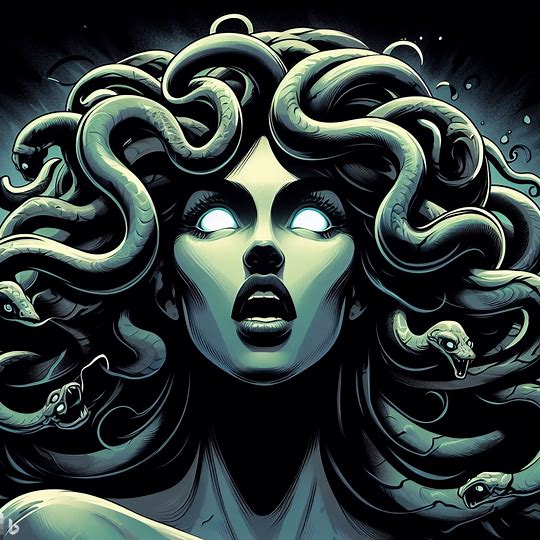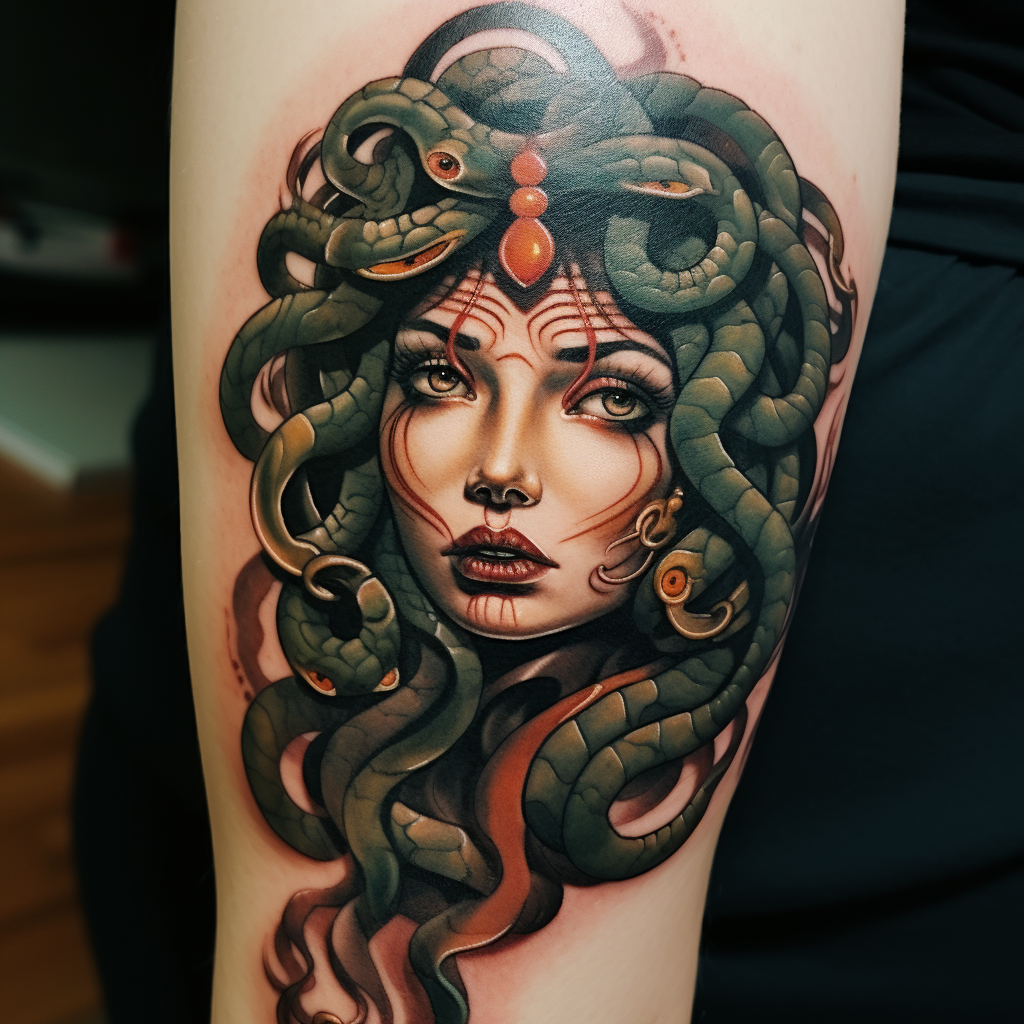Medusa Tattoo Meaning & Ideas
 Medusa Tattoo Design
Medusa Tattoo Design
One of the most enigmatic and enduring figures from Greek mythology is Medusa, a character shrouded in myth, mystery, and a multitude of interpretations and meanings. While many know her as the snake-haired monster who turns people to stone with a mere glance, the tale of Medusa is far more complex and multi-layered. This article dives into the intricate layers of the Medusa tattoo, from its historical origins to its contemporary significance, providing insight into why this design has gained popularity and how both clients and artists can approach it.
Tattoos have long served as a means for self-expression, and the Medusa tattoo is a prime example of how body art can convey powerful messages. In the realm of ink, the Medusa tattoo has taken on a particularly profound meaning, often symbolizing survival and strength in the face of sexual assault or abuse.
Who Is Medusa?
Born from the sea deities Phorcys and Ceto, Medusa is a fascinating character for several reasons, not the least of which is her mortality. Unlike her immortal Gorgon sisters, Stheno and Euryale, Medusa was mortal. Her family also includes other mythological figures like the Graeae and the Hesperides. The contrast between her mortality and the immortality of her family adds a layer of complexity to her character right from her inception.
The tale of Medusa, as depicted in Greek mythology, introduces us to a young and beautiful woman who once served as a priestess of Athena, the goddess of war and wisdom. However, her beauty garnered unwanted attention, leading to a traumatic incident where she was brutally assaulted by Poseidon, the god of the sea. In response, Athena transformed Medusa into a gorgon with snakes for hair, a horrifying form capable of turning onlookers to stone. This narrative reflects an early example of victim-blaming and the transformation of a survivor into a symbol of terror.
Medusa’s life was cut short by the Greek hero Perseus, who was aided by the gods Hermes and Athena. Using a mirrored shield to avoid her petrifying gaze, Perseus successfully beheaded Medusa. From her severed head sprang two new beings—Pegasus, the winged horse, and Chrysaor, whose form varies between myths as either a giant or a golden sword. In this way, even in death, Medusa gave life to other mythical beings.
Medusa’s image has captivated artists and writers for centuries. Her visage has been portrayed in a plethora of media, from ancient pottery and sculptures to Renaissance paintings and modern art. Interestingly, the depiction of Medusa has evolved over time. While earlier representations focused on her monstrous aspects, later artworks portray her in a more human-like form. Beyond art, her face has served as an apotropaic symbol, known as the Gorgoneion, used to ward off evil.
Medusa is not just a character in a myth; she’s a symbol, laden with multiple meanings and interpretations. She embodies themes of danger and protection, monstrosity and beauty. Her story and image have transcended Greek mythology to become part of a larger cultural dialogue, inspiring countless interpretations and adaptations.
Download These Medusa Tattoo Designs Here
What Does a Medusa Tattoo Mean?
The Medusa tattoo holds multifaceted meanings. It often serves as a symbol of survival, strength, and resilience for individuals who have experienced sexual assault or abuse.
To comprehend the full weight of what a Medusa tattoo represents, it’s essential to first understand the myth behind the figure. In ancient Greek mythology, Medusa was initially a beautiful priestess in the temple of Athena. However, after being raped by Poseidon, she was transformed by Athena to a monster with snakes as her hair and a gaze that turned people to stone. It’s a tale fraught with injustice, victim-blaming, and the retributive wrath of the gods.
While the popular retelling of Medusa’s story often casts her as a fearsome monster to be vanquished, a closer look reveals her to be a victim of circumstance and divine cruelty. Many argue that Medusa didn’t deserve her plight; she was victimized first by Poseidon and then further punished by Athena. In this context, Medusa tattoos can be seen as a defiant act of reclaiming a narrative that has been historically skewed. They serve as a tribute to a figure that endured, who transformed her victimhood into an otherworldly power—albeit a curse—and who commands respect and invokes awe.
Medusa tattoos are often sought after by survivors of abuse and assault, serving as a constant reminder of their resilience and ability to transform pain into strength. Just as Medusa was forced to evolve into something fearsome from her tragic circumstances, the tattoo symbolizes the bearer’s capacity for metamorphosis in the face of adversity. Medusa is a figure who was dealt a terrible hand yet still stood formidable and powerful; her image serves as a daily reminder of strength and endurance.
The Medusa tattoo has also been embraced as a symbol of defiance against patriarchal structures that have historically demonized powerful women. The act of choosing such an evocative image can be a form of reclaiming agency, a way to wear one’s strength, defiance, and resilience as a badge of honor. This defiance extends to combating victim-blaming—a prevalent issue in conversations about sexual assault. Medusa, as an unfairly maligned figure, symbolizes the societal urge to blame the victim rather than address the real roots of misogyny and abuse.![]()
Warding Off Evil and Expressing Sexuality
Some wearers of the Medusa tattoo even view it as a form of protection—a talisman against evil. The belief that the Medusa gaze could turn people to stone can be interpreted as a way to deter ill will or malintent. Furthermore, given that Medusa was originally a figure of beauty and later a figure of terror, the tattoo can also symbolize the complexities of female sexuality—both its allure and its power.
Medusa Design Ideas
Here are some design choices to consider when looking at this tattoo.
- Medusa’s Head Only:
- Focusing solely on Medusa’s head allows for intricate detailing of her snake hair, intense gaze, and facial features.
- This minimalist approach emphasizes her iconic petrifying ability and her transformation from beauty to monstrosity.
- Full Medusa:
- A full Medusa tattoo includes her entire figure, depicting her as a gorgon with wings, snakes for hair, and a monstrous appearance.
- This design choice captures her powerful and fearsome nature, embracing both her beauty and her terror.
- Profile View:
- A profile view of Medusa showcases the contours of her face and the sinuous curves of her snake hair.
- This perspective highlights her enchanting allure while emphasizing her mythical transformation.
- Frontal View:
- A frontal view of Medusa’s face brings out the intensity of her gaze and her facial expression.
- This design choice focuses on capturing the emotional impact of her story and her role as a symbol of empowerment.
- Close-Up Eyes:
- Zooming in on Medusa’s eyes emphasizes the petrifying power they possess.
- This design can be both captivating and eerie, showcasing her ability to turn onlookers to stone with a single glance.
- Abstract Representation:
- An abstract Medusa tattoo may incorporate elements of her story, such as snakes, stone textures, or Greek motifs, in a more stylized manner.
- This approach allows for creative interpretation while still evoking the essence of Medusa’s myth.
- Medusa in Artistic Style:
- Tattoos inspired by artistic movements like realism, watercolor, or neo-traditional can offer unique and visually striking takes on Medusa.
- These styles add depth and emotion to her portrayal, enhancing the symbolism of the design.
- Medusa with Athena:
- Depicting Medusa and Athena together can capture the pivotal moment of Medusa’s transformation, emphasizing themes of betrayal and empowerment.
- This choice adds a narrative layer to the tattoo and showcases the complexity of their relationship.
- Symbolic Elements:
- Incorporating additional symbols, such as stone statues or Athena’s shield, can enhance the storytelling aspect of the design.
- These elements contribute to the broader context of Medusa’s myth and her role as a multifaceted symbol.
- Color Palette:
- The color palette you choose can dramatically influence the mood and tone of the tattoo.
- A monochromatic scheme may emphasize the mythological and dramatic aspects, while vibrant colors can add a contemporary and personalized touch.
Medusa Tattoo Meaning
Victim and Symbol of Empowerment
Medusa’s transformation from a beautiful woman to a monstrous figure highlights the themes of victimization and the consequences of sexual assault. In modern times, some interpretations view her as a symbol of empowerment and resilience, representing survivors who refuse to be defined by their traumatic experiences.
Feminine Empowerment
In recent feminist interpretations, Medusa’s story has been reclaimed as a symbol of feminine strength and resistance against oppression. She represents women’s ability to defy conventional beauty norms and patriarchal expectations.
Art and Culture
Medusa has been a popular subject in art and literature for centuries. Artists have depicted her in various forms, capturing her eerie beauty and the dichotomy between her once-beautiful human self and her monstrous appearance.
Mythical Symbolism
Medusa’s tale embodies themes of transformation, punishment, and the balance of power between gods and mortals in Greek mythology. Medusa’s story is a cautionary tale about the dangers of hubris and disrespecting sacred spaces.
Considering a Medusa Tattoo?
First and foremost do research on the type of design you’re envisioning for the tattoo. Things like colors, style, sizing, placement are all crucial to coming up with the best design for yourself. If you’re overwhelmed with the design process, one of the easiest things you can do is to find inspiration and bring that to a tattoo artist that you trust to do the work. This allows you to show off different aspects of different designs and to communicate what about the Medusa tattoo is important to you.
Research your tattoo artist thoroughly, particularly seeking out specialists in Medusa designs. There might be someone that is known for their Medusa, so seek them out and see if it’d be feasible to meet up.
Medusa Tattoo Placement
Contemplate the tattoo’s placement on your body and its potential implications. Choose a location that aligns with your comfort level and willingness to engage in discussions about the tattoo’s meaning. Ultimately, the decision should reflect your agency and self-expression.
Wrapping Up Medusa Tattoo
The Medusa tattoo serves as a poignant reminder that body art can transcend aesthetics, carrying deep emotional narratives and fostering connection. Its symbolism extends from personal triumph over adversity to admiration for mythology and design. With an increasing number of individuals embracing the Medusa tattoo, it’s clear that this symbol is not only artistically captivating but also a testament to the strength and resilience of survivors.
- Arm Swollen After a Tattoo? What You Need to Know
- Tattoo Aftercare: How to Reduce Tattoo Swelling & Discomfort
- Tattoo Aftercare Products & How They Fit Into Caring for Your Tattoo
- How To Brighten a Tattoo
- American Traditional Tattoo Style
- Best Tattoo Lotions For New or Old Tattoos
- This Too Shall Pass Tattoo
- Butterfly Tattoo
- Tattoo Ideas for Men: How To Find The Perfect Design
- Why Does My Tattoo Look Faded? Great Tattoo Aftercare Tips
- Flowers (7)
- Halloween (5)
- Uncategorized (92)





